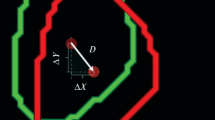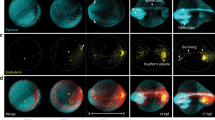Abstract
The surface of Xenopus laevis embryos was marked with carbon particles, after which the location of mark groups was recorded by time-lapse video imaging and subsequent image analysis until their disappearance in the depth of gastric invagination. Measuring the distances between individually identifiable marks whose size is smaller than the size of a single cell makes it possible to quantitatively analyze the geometry of collective cell movement without any external coordinate system. During the dorsal blastopore lip (DBL) formation, the invagination of surface cells fundamentally differs from the preceding and subsequent lateromedial (LM) intercalation, being associated with a decrease in the meridional distance and an increase in the latitudinal distance between the marked surface sites. The sites that began to move towards the DBL later overtake the areas that started movement earlier, which leads to a “plug” in the movement of cells. Pushing the “plug” into the inner layers by changing the DBL shape becomes the rate-limiting stage of gastrulation; then, the directed cell movement is replaced by epiboly based on LM intercalation when the marks remaining on the outer surface of the marginal zone diverge along its meridians without directed migration towards the blastopore. As a result, directional movement of cells and LM intercalation become successive phases of collective cell movement, and the entire morphogenesis of DBL is the direct consequence of epiboly deceleration occurring upon gastric invagination.
Similar content being viewed by others
References
Arnol’d, V.I., Teoriya katastrof (Catastrophe Theory), Moscow: Nauka, 1990.
Belintsev, B.N., Beloussov, L.V., and Zaraisky, A.G., Model of pattern formation in epithelial morphogenesis, J. Theor. Biol., 1987, vol. 4, no. 129, pp. 369–394.
Belintsev, B.N., Fizicheskie osnovy formoobrazovaniya (Physical Fundamentals of Morphogenesis), Moscow: Nauka, 1990.
Belousov, L.V., Luchinskaya, N.N., and Zaraiskii, A.G., Tensotaxis–collective movement of embryonic cells up along the gradients of mechanical tensions, Russ. J. Dev. Biol., 1999, vol. 30, no. 3, pp. 190–197.
Beloussov, L.V. and Grabovsky, V.I., Morphomechanics: goals, basic experiments and models, Int. J. Dev. Biol., 2006, vol. 50, pp. 81–91.
Beloussov, L.V., Morphomechanics of Development, Springer, 2015.
Cherdantsev, V.G., Morfogenez i evolyutsiya (Morphogenesis and Evolution), Moscow: Izd. KMK, 2003.
Cherdantsev, V.G., The dynamic geometry of mass cell movements in animal morphogenesis, Int. J. Dev. Biol., 2006, vol. 50, pp. 169–182.
Cherdantsev, V.G., Generic oscillation patterns of the developing systems and their role in the origin and evolution of ontogeny, BioSystems, 2014, vol. 123, pp. 37–53.
Cherdantsev, V.G. and Grigorieva, O.V., Morphogenesis of active shells, BioSystems, 2012, vol. 109, pp. 114–128.
Cherdantsev, V.G. and Korvin-Pavlovskaya, E.G., Variability of quantitative morphological traits and the formation of dorsoventral differences in early morphogenesis of the loach, Missgurnus fossilis L., 2016, 2, vol. 47, pp. 1–16.
Cherdantsev, V.G. and Scobeyeva, V.A., Morphogenetic origin of natural variation, BioSystems, 2012, vol. 109, pp. 299–313.
Ewald, A.E., Peyrot, S.M., Tyszka, J.M., Fraser, S.E., and Wallingford, J.B., Regional requirements for Dishevelled signaling during Xenopus gastrulation: separable effects on blastopore closure, mesendoderm internalization and archenteron formation, Development, 2004, vol. 131, pp. 6192–6209.
Gerhart, J., Evolution of the Organizer and the chordate body plan, Int. J. Dev. Biol., 2001, vol. 45, pp. 133–153.
Hardin, J. and Keller, R., The behavior and function of bottle cells during gastrulation of Xenopus laevis, Development, 1988, vol. 103, pp. 211–230.
Keller, R. and Shook, D., Gastrulation in amphibians, in Gastrulation: From Cell to Embryo, Stern, D.S., Ed., 2004, pp. 7–62.
Keller, R.E., An experimental analysis of the role of bottle cells and the deep marginal zone in gastrulation of Xenopus laevis, J. Exp. Zool., 1981, vol. 216, pp. 81–101.
Keller, R.E., The cellular basis of amphibian gastrulation, Int. J. Dev. Biol., 1986, vol. 45, pp. 241–327.
Keller, R. and Tibbetts, P., Mediolateral cell intercalation in the dorsal, axial mesoderm of Xenopus laevis, Dev Biol., 1989, vol. 131, pp. 539–549.
Keller, R. and Shook, D., Dynamic determinations: patterning the cell behaviors that close the amphibian blastopore, Phil. Trans. Roy. Soc. London: B Biol. Sci., 2008, vol. 363, pp. 1317–1332.
Landau, L.D. and Lifshits, E.M., Statisticheskaya fizika (Statistical Physics), Moscow: Nauka, 1976, part 1.
Lerchner, W., Latinkic, B.V., Remacle, J.E., Huylebroeck, D., and Smith, J.C., Region-specific activation of the Xenopus Brachyury promoter involves active repression in ectoderm and endoderm: a study using transgenic frog embryos, Development, 2000, vol. 127, pp. 2729–2739.
Neklyudova, I.V., Korvin-Pavlovskaya, E.G., and Cherdantsev, V.G., Spatial-temporal dynamics of morphogenetic blastoderm potencies in early embryogenesis of the loach, Russ. J. Dev. Biol., 2007, vol. 38, no. 5, pp. 294–309.
Odell, G.M., Oster, G., Alberch, P., and Burnside, B., The mechanical basis of morphogenesis. I. Epithelial folding and invagination, Dev. Biol., 1981, vol. 85, pp. 446–462.
Prigogine, I., From Being to Becoming. Time and Complexity in Physical Sciences, New York: W.H. Forman and Co, 1980.
Scobeyeva, V.A., The natural variability of morphogenesis: a tool for exploring the mechanics of gastrulation movements in amphibian embryos, Int. J. Dev. Biol., 2006, vol. 50, pp. 315–322.
Wallingford, J.B., Fraser, S.E., and Harland, R.M., Convergent extension: the molecular control of polarized cell movement during embryonic development, Dev. Cell, 2002, vol. 2, pp. 695–706.
Wilson, P. and Keller, R., Cell rearrangement during gastrulation of Xenopus: direct observation of cultured explants, Development, 1991, vol. 112, pp. 289–300.
Winklbauer, R. and Schuerfeld, M., Vegetal rotation, a new gastrulation movement involved in the internalization of the mesoderm and endoderm in Xenopus, Development, 1999, vol. 126, pp. 3703–3713.
Author information
Authors and Affiliations
Corresponding author
Additional information
Original Russian Text © E.G. Korvin-Pavlovskaya, V.G. Cherdantsev, 2016, published in Ontogenez, 2016, Vol. 47, No. 4, pp. 251–266.
Rights and permissions
About this article
Cite this article
Korvin-Pavlovskaya, E.G., Cherdantsev, V.G. Geometry of movement of the outer surface of the embryo during Xenopus gastrulation. Russ J Dev Biol 47, 223–237 (2016). https://doi.org/10.1134/S1062360416040056
Received:
Accepted:
Published:
Issue Date:
DOI: https://doi.org/10.1134/S1062360416040056




